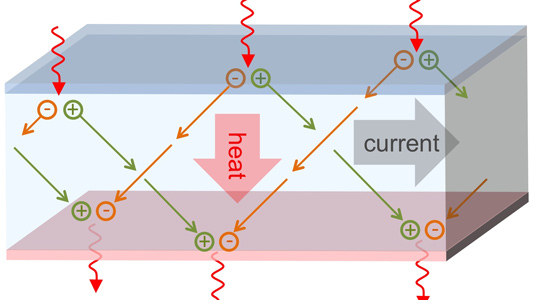Moving Heat Sideways with Transverse Thermoelectrics
McCormick researchers develop strategy to fabricate semiconductors that drive heat perpendicular to an applied electric current

Thermoelectrics — materials that convert heat to electrical energy and vice-versa — currently find everyday use in portable refrigerators and waste heat electrical generators. However, devices made of standard materials with positive (“p-type”) or negative (“n-type”) charges moving parallel to the heat flow cannot be scaled down in size much smaller than a millimeter, and they stop operating at cryogenic temperatures below 150 K.
Northwestern University researchers recently developed a strategy to fabricate semiconductors in which positive and negative charges move perpendicular to each other (called “p n-type” or “p-by-n-type”), inducing heat to flow transverse to the electrical current. This opens the door for novel thermoelectric applications, particularly at small scales and at cryogenic temperatures where current technologies fail.
 “We have broken the century-old paradigm that says the only important parameter for a thermoelectric material is its figure of merit, which summarizes all of the intrinsic material properties. Transverse thermoelectrics can exceed the performance dictated by their figure of merit when the material is shaped to the task at hand,” said Matthew Grayson, associate professor of electrical engineering and computer science at Northwestern’s McCormick School of Engineering. “This theoretical proposal should guide the discovery of many new materials and inspire many new device applications in the near future.”
“We have broken the century-old paradigm that says the only important parameter for a thermoelectric material is its figure of merit, which summarizes all of the intrinsic material properties. Transverse thermoelectrics can exceed the performance dictated by their figure of merit when the material is shaped to the task at hand,” said Matthew Grayson, associate professor of electrical engineering and computer science at Northwestern’s McCormick School of Engineering. “This theoretical proposal should guide the discovery of many new materials and inspire many new device applications in the near future.”
A paper describing the research, "Driving Perpendicular Heat Flow: P x N-Type Transverse Thermoelectrics for Microscale and Cryogenic Peltier Cooling,” was published May 31 in the journal Physical Review Letters.
A coherent strategy to identify or engineer such transverse thermoelectric materials was missing until now. Focusing on a type II superlattice with alternating layers of indium arsenide and gallium antimonide (InAs/GaSb), the researchers determined that the superlattice possesses orthogonal p-type and n-type characteristics and described how such materials could be fabricated.
While standard materials are extensively used in today’s thermoelectric devices, tremendous opportunities for new applications arise with these transverse thermoelectrics.
These transverse thermoelectrics could operate at very low temperatures or be scaled down to very small sizes. It then becomes possible to scale down solid-state refrigerators to micron-size cooling devices that could be built into integrated circuits.
The materials also have potential for refrigerating to cryogenic temperatures and converting a few degrees of temperature difference around room temperature into hundreds of volts of electrical potential — all with a single piece of appropriately shaped material.
The research was funded by the Air Force Office of Scientific Research, NSF Materials Research Science and Engineering Center (MRSEC) at Northwestern, and the Initiative for Sustainability and Energy at Northwestern (ISEN).
The paper was highlighted as a top paper of the week in Physical Review Letters.